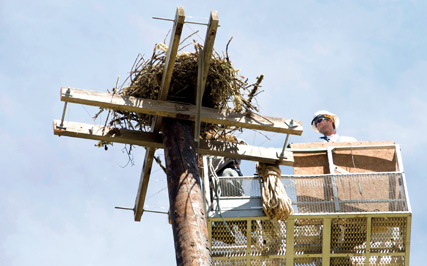Tribal Government & News
Tribe organizes effort to save local osprey nest

For some things it takes a village, but to raise an osprey, it looks like a concerned citizen and a Tribal Natural Resources staff member with a good contact at Bonneville Power Administration can handle the job.
In Grand Ronde recently, that concerned citizen was Tresa Mercier, a Tribal member who works in the business office of the Tribal Health Clinic. Her contact was Kelly Dirksen, coordinator of Fish and Wildlife in the Tribe's Natural Resources Department.
The issue? Osprey were building a nest on high voltage wires at the Portland General Electric substation next door to the former Willamina Middle School building.
Dirksen contacted PGE and BPA to see how they handle this kind of situation. The osprey started building their nest and the electric companies then, coincidentally, shut off power to inspect the poles. With the power off, the birds built out over the wires and ceramic insulators that would be live when the power came back on. The question was: How to handle the birds and the nest before turning the power back on?
"We watched them all week," said Ben Tilley, a BPA Natural Resource specialist. "On Wednesday (June 15), we decided on a plan of action."
In conjunction with Dirksen, BPA planned to plant a new pole in the substation. Osprey favor the highest post, so a new one, taller than the 80-foot posts that currently hold the wires, was recruited from a BPA storage yard and planted on Friday, June 17.
Nearly 100 feet up, BPA linemen on the "live line crew" took a bucket up to the nest, slid it onto a sheet of plywood and held it on the bucket. They moved the bucket over to the new post, where the nest was tucked into place on cross beams and exposed bolts around which, Tilley was fairly certain, the osprey would tidy things up and generally make sure the nest was secure.
The poles with the live wires were fitted with deterrents to keep the osprey from moving back there.
Still undetermined, said Dirksen, is whether the birds will take to the nest after this human interference.
"There is a very good chance that the pair will abandon the nest after the crew tries to relocate it," Dirksen wrote to Mercier in an e-mail. "If they abandon it this year there is a very good chance they will come back next year at the new site."
Of course, the local school next door is also now empty, but osprey move into neighborhoods for more than just good schools.
Osprey live almost entirely on a diet of live fish, Dirksen said, so their presence in the area "is a reasonable indicator (of the health) of this arm of the South Yamhill River."
"I think it's neat," he added, "that Tresa reaches out with an e-mail and in the end there is a new and safer home for birds. It was hard to imagine at the start that in the end BPA and PGE would install an expensive 100-foot pole and platform that will provide a better and safer nest for the future. I'm thankful things worked out this well, (but) hoping she doesn't call me about some beached whale."
